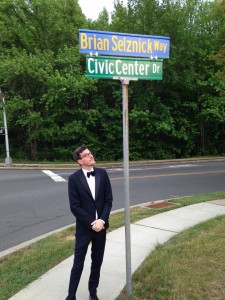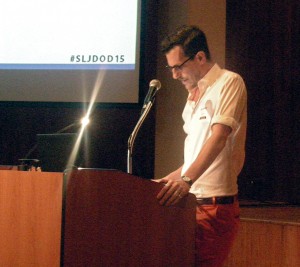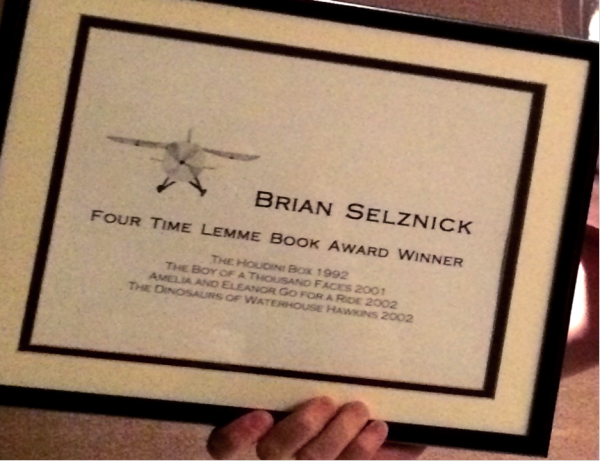Brian Selznick on Inspirations, a Personal Challenge, and His New Book | Day of Dialog 2015
In his opening Day of Dialog speech, "The Invention of Hugo Cabret" author paid tribute to librarians and described his personal challenge to make each book better than the last, along with a theme in his books: a quest to create a family.

Brian Selznick with a document describing the four Lemme Book Awards bestowed upon his books by students at an Iowa City elementary school.
“Librarians offer a window onto the world,” Brian Selznick said during a dynamic, humorous, and heartfelt speech that kicked off SLJ’s Day of Dialog last week. Recalling his elementary school library in East Brunswick, NJ, the Caldecott Medal–winning author said, “I loved the wonder of the library, the fact that all of those books could be mine.” The illustrator, storyteller, and author of groundbreaking visual novels, including the 2008 Caldecott Medalist The Invention of Hugo Cabret (Scholastic, 2007), opened by paying tribute to librarians who have supported him over the years. He went on talk about his creative process, his personal challenge to make each book better than the previous one, and the theme that run through his three latest books: a quest to create a family. His hometown East Brunswick Public Library lent out objects, such as reproductions of Egyptian heads and Degas bronze sculptures, as well as books, Selznick told the audience. He liked “knowing that I was the proud owner [of an object] and could touch [it] all I wanted” for a short time. Selznick also researched his first book, The Houdini Box (Knopf, 1991), at that library. “It was a librarian who first reached out to me, letting me know that [my first book] might be a success,” Selznick went on. He described his relationship with Barbara Gross, an assertive school librarian in Pennsylvania, who called Selznick at his day job at the now-closed bookstore Eeyore’s Books for Children in New York City after The Houdini Box came out.
When Selznick hosted an event at his hometown East Brunswick Public Library last week, a local street was temporarily renamed in his honor.
“She said that it was the best book she’s read in a long time and I was going to come to Pennsylvania and her school and talk to her kids and I was going to stay at her house and she was going to throw a party in my honor,” he said. “I found myself unable to say anything except, ‘Uh, ok?’” “Before I knew it, I was unpacking my luggage in Barbara’s spare bedroom,” Selznick told the amused crowd; he met authors Jerry and Eileen Spinelli at the promised party. “I’ve met librarians from all over the country,” Selznick continued. Memorable characters included Nancy Westlake, who sent him a box full of hand-made Caldecott-type medals made by students at her Iowa City school, with notification that The Houdini Box had won the “Lemme Award” for best book—selected by students and named after their school. “I don’t want to brag, but I went on to win four [Lemme Awards],” Selznick said. He also befriended the “extraordinary” Yvonne Cech, a librarian at the Sandy Hook Elementary School in Newtown, CT, when he spoke there.Assembling a story
“Working on my third or fourth book, someone asked me if I thought my books were getting better,” he said. “I couldn’t quite say that [my books] were better than The Houdini Box. After that, my goal with each book was to make them better”—meaning “I would take the things I learned from the previous books and do something new with it I hadn’t done before. I was to try to never repeat myself.”
At the SLJ Day of Dialog podium.
“Hugo typifies the biggest leap I took with this idea,” he said. “Now I’ve attempted to rethink the use [of words and pictures] in my new book, The Marvels,” which Scholastic is releasing in September. Hugo Cabret, hailed for its innovative format, is a 550-page tale told in alternating prose and Selznick's signature black-and-white pencil drawings. In his next work, Wonderstruck (Scholastic, 2011), “pictures reflect the experience of the main character,” a deaf girl named Rose who encounters the world visually, Selznick said. The Marvels, at 660 pages, is made up of two connected tales, one told entirely in illustrations, followed by another in narrative prose, set centuries later. Selznick described his process of assembling a narrative. “When I begin a book, I generally don’t think about themes…I think about plot, or I’ll have one specific image [that] I’ll work around.” “Often, the last element to fall into place is emotions,” he said. “It’s the emotion that’s the most important part. If you don’t care...the plot won’t matter.” Hugo Cabret, he said, was sparked by his realization that the early filmmaker Georges Méliès, who plays a key fictionalized role in the story, “had a collection of automatons that were thrown away. Which led to the image of a boy finding one of those broken machines and trying to fix it.” “With Wonderstruck, [the inspiration] was learning that the introduction of sound film in 1927, hailed as a triumph, was in fact a tragedy for the deaf community,” he said. The book tells the stories of two characters, generation apart—Rose, growing up in the 1920s, and a grown man who loses his hearing, set many years later—that ultimately converge at the American Museum of Natural History in New York City. “The Marvels grew partially out of my love for the theater,” Selznick said. ‘The entire visual narrative happens first—all 400 pages of it. Yeah, that’s what I’ve been doing for the last three years.” He also said that a historic home in London, Dennis Severs House, at 18 Folgate Street, also “served as an inspiration” for The Marvels. The first part of the book, opening in 1788, follows a boy who works at a London theater after a shipwreck, and chronicles the many subsequent generations of actors in his family who follow in his footsteps. The second opens with a boy on a London street in 1990, and the tale “weaves back and forth.”Creating your own family
Selznick said that he doesn’t necessarily notice themes in his books until other people point them out. “When I was on tour for Hugo, I loved that someone told me that the book was about a person creating his own family,” he said. “I didn’t know that’s what it was about.” He reflected on this idea and his own experience growing up gay. “I didn’t know any gay people until college,” he told the audience. “I made the connection between growing up gay, and maybe deaf people don’t meet other deaf people until college, and then I realized that in the back of my head, I wanted that theme of creating your own family to be in Wonderstruck. In The Marvels, I’ve finished a trilogy in that theme...a very heavy trilogy.” He added that his friend Maurice Sendak thought of his books Where the Wild Things Are, Outside over There, and In the Night Kitchen as a trilogy, all drawing on elements of his childhood. In closing, Selznick described going down to the Thames River during a recent visit to London and “mudlarking”—looking at things that had washed up on the shore. “The beach was scattered with different colored stones and rocks, small bits and pieces of London history that have fallen into the river and washed up on the shore over tens or thousands of years,” he said. It made him think about “the vast power of storytelling—stories passed down from generation to generation, and the ability to transform life into a story over powerlessness. That’s what The Marvels is about—the triumph of storytelling.”
He added that his friend Maurice Sendak thought of his books Where the Wild Things Are, Outside over There, and In the Night Kitchen as a trilogy, all drawing on elements of his childhood. In closing, Selznick described going down to the Thames River during a recent visit to London and “mudlarking”—looking at things that had washed up on the shore. “The beach was scattered with different colored stones and rocks, small bits and pieces of London history that have fallen into the river and washed up on the shore over tens or thousands of years,” he said. It made him think about “the vast power of storytelling—stories passed down from generation to generation, and the ability to transform life into a story over powerlessness. That’s what The Marvels is about—the triumph of storytelling.” RELATED
RECOMMENDED
CAREERS
The job outlook in 2030: Librarians will be in demand
CAREERS
The job outlook in 2030: Librarians will be in demand
ALREADY A SUBSCRIBER? LOG IN
We are currently offering this content for free. Sign up now to activate your personal profile, where you can save articles for future viewing





Add Comment :-
Be the first reader to comment.
Comment Policy:
Comment should not be empty !!!